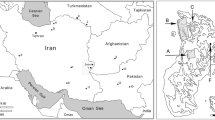Abstract
This study focuses on the archeological characterization of potsherds from Tigranakert in Artsakh belonging to different centuries (from 9–13 century) using SEM/EDS technique. Archeometry and archeological science correspond and refer to the application of scientific techniques to the analysis of archeological materials, as well as the processes involved in their manufacture (Williams, Late Roman Coarse Wares, Cooking Wares and Amphorae in the Mediterranean: Archaeology and Archaeometry, BAR International Series, London, 2005; Vigil de la Villa Mencía and García Giménez, La Ciencia y el Arte: Ciencias Experimentales y Conservación del Patrimonio Histórico. Instituto del Patrimonio Histórico Español, Madrid, 2008; Martinón-Torres and Killick, The Oxford Handbook of Archaeological Theory, Oxford University Press, Oxford, 2015). This paper presents a study of a set of ceramic samples using stratigraphic analysis coupled with SEM/EDX technique. Ceramic materials provide information on the clay materials employed in their manufacture (Hradil et al., Appl Clay Sci 165:135–147, 2018; Giannossa et al., J Cult Herit 43:242–248, 2020), hence facilitating the assignment of their autochthonous or allochthonous character (Kordatzaki et al., J Archaeol Sci Rep 7:526–529, 2016; Montana, Anthropol Sci12:175, 2020; Hein and Kilikoglou, Anthropol Sci 12:180, 2020). Analysis of the cross-section provides the stratigraphic evaluation of the ceramic body (holes, cavities, imperfections, granulometry, inclusions, and color), the glaze, or other superficial layers (glazes, transparency or opacity, color and saturation, defects, and other). SEM images showed that the potsherds have a quite poor vitrification degree and heterogeneous grain distribution, suggesting a simple firing technique.












Similar content being viewed by others
Data availability
No datasets were generated or analysed during the current study.
References
Burleson M (2003) The ceramic glaze handbook materials, techniques, formulas, revised ed. Lark Books, New York
Giannossa LC, Muntoni IM, Laviano R, Mangone A (2020) Building a step-by-step result in archaeometry. Raw materials, provenance and production technology of Apulian Red Figure pottery. J Cult Herit 43:242–248
Godet M et al (2019) Multi-scale investigation of body-glaze interface in ancient ceramics. Heritage 2(3):2480–2494
Hein H, Kilikoglou V (2020) Ceramic raw materials: how to recognize them and locate the supply basins: chemistry. Archaeol Anthropol Sci 12:180
Hradil D, Hradilová J, Holcová K, Bezdicˇka P (2018) The use of pottery clay for canvas priming in Italian Baroque—an example of technology transfer. Appl Clay Sci 165:135–147
Iserlis M, Goren, Hovsepyan I, Greenberg R (2015) Early Kura-Araxes ceramic technology in the fourth millennium BCE, site of Tsaghkasar, Armenia. Paléorient 41(1):9–23 © CNRS éditions
Kordatzaki G, Kiriatzi E, Müller NS, Voyatzis M, Romano D, Petrakis S, Forsén J, Nordquist G, Rodriguez-Alvarez E, Linn S (2016) A diachronic investigation of ‘local’ pottery production and supply at the sanctuary of Zeus, Mount Lykaion, Arcadia. Peloponnese J Archaeol Sci Rep 7:526–529
Martinón-Torres M, Killick D (2015) Archaeological theories and archaeological sciences. In: Gardner A (ed) The oxford handbook of archaeological theory. Oxford University Press, Oxford, p 32
Montana G (2020) Ceramic raw materials: how to recognize them and locate the supply basins—mineralogy, petrography. Archaeol Anthropol Sci 12:175
Navasardyan KH (1990) Hayastani m.t‘.a. III hazaramyaki xec‘ełeni t‘rcman ̃ermastičani masin (On Firing Temperature of III Millennium B.C. Ceramics of Armenia). BEH 3(72):136–141
Navasardyan KH (1991) Hayastani vał bronzedaryan xec‘ełeni artadrut‘yan voroš texnikatexnologiakan aŕanjnahatkut‘yunneri masin (On Certain Technical-Technological Specifics of Early Bronze Age, Ceramics of Armenia). BEH 3(75):126–131
Palamara E, Zacharias N, Xanthopoulou M, Kasztovzsky ZS, Kovács I, Palles D, Kamitsos EI (2016) Technology issues of Byzantine glazed pottery from Corinth. Greece Microchem J 129:137–150. https://doi.org/10.1016/j.microc.2016.06.0080026-265X
Petrosyan H (2020) Tigranakert of Artsakh, Armenian Journal of Near Eastern Studies. Armenian archaeology. Past experiences and new achievements. Archaeopress Archeology 10(1–2):327–371
Petrosyan H (2021) Cultural heritage experiences & perspectives in international context, proceedings of the Rochemp center international conference, January 23rd–24th, 2020, Armenia. ELECTRUM 28:163–187. https://doi.org/10.4467/20800909EL.21.012.13370; www.ejournals.eu/electrum
Petrosyan H, Kalantaryan A, Karakhanyan G, Melkonyan H (2009) Armenia in the cultural context of east and west. Ceramics and Glass (4th–14th centuries), Yerevan
Petrosyan H, Safaryan V, Karapetyan I, Kirakosyan L, Vardanyan R, Vardanesova V, Gabrielyan A (2019) Pithos Burials of Tirganakert in Artsakh, archaeology of Armenia in regional context. Proceedings of the International Conference dedicated to the 60th Anniversary of the Institute of Archaeology and Ethnography Held on July 9–11, 2019 in Yerevan, Edt byPavel Avetisyan and Arsen Bobokhyan
Tite MS, Freestone I, Mason R, Molera J, Vendrell-Saz M, Wood N (1998) Lead glazes in antiquity-methods of production and reasons for use. Archeometry 40:241–260. https://doi.org/10.1111/j.1475-4754.1998.tb00836.x
Vigil de la Villa Mencía R, García Giménez R (2008) Cerámica y su caracterización. In: Antonio Molina C, Carrión Martín MD, Jiménez Jiménez J (eds) La Ciencia y el Arte: Ciencias Experimentales y Conservación del Patrimonio Histórico. Instituto del Patrimonio Histórico Español, Madrid, pp 223–233
Williams DF (2005) An integrated archaeometric approach ceramic fabric recognition. A study on Late Roman amphora 1 from the eastern Mediterranean. In: Gurt i Esparraguera JM, Buxeda i Garrigós J, Cau Ontiveros MA (eds) Late Roman Coarse Wares, Cooking, Wares and Amphorae in the Mediterranean: Archaeology and Archaeometry, vol 1340. BAR International Series, London, pp 613–624
Funding
This research did not receive any specific grant from funding agencies in the public, commercial, or not-for-profit sectors.
Author information
Authors and Affiliations
Contributions
YK and GL wrote the main manuscript text. HP and TV archaeological partexperimental part.
Corresponding author
Ethics declarations
Conflict of interests
The authors declare no competing interests.
Additional information
Publisher's Note
Springer Nature remains neutral with regard to jurisdictional claims in published maps and institutional affiliations.
Rights and permissions
Springer Nature or its licensor (e.g. a society or other partner) holds exclusive rights to this article under a publishing agreement with the author(s) or other rightsholder(s); author self-archiving of the accepted manuscript version of this article is solely governed by the terms of such publishing agreement and applicable law.
About this article
Cite this article
Keheyan, Y., Lanterna, G., Petrosyan, H. et al. Spectroscopic techniques for the characterization of the potsherds from Tigranakert in Artsakh. Rend. Fis. Acc. Lincei (2024). https://doi.org/10.1007/s12210-024-01244-x
Received:
Accepted:
Published:
DOI: https://doi.org/10.1007/s12210-024-01244-x




